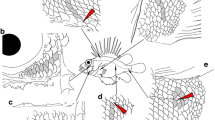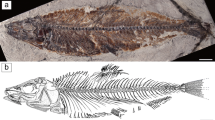Abstract
A new clupeomorph fish,Sorbinichthys elusivo n. g., n. sp. is described from a new Upper Cretaceous (Middle ? Cenomanian) marine locality at Nammoura (Lebanon). The characteristic features of the new genus, such as dorsally expanded posttemporal, subrhomboid spiny dorsal scutes, a very wide and deep gap between second and third hypurals, second ray of dorsal and pectoral fins greatly elongated and filamentous, and anterior procurrent caudal fin rays deeply extended between vertebral spines are unusual for clupeomorphs and warrant the establishment of the new family Sorbinichthyidae. The new fish displays several clupeomorph and clupeiform characters, but its placement within the clupeiforms is problematic. The new family is referred to the Clupeomorpha incertae ordinis.
Kurzfassung
Ein neuer clupeomorpher Fisch,Sorbinichthys elusivo n. g., n. sp. wird beschrieben. Er stammt von einer ebenfalls neuen Lokalität, Nammoura, die in die marine Oberkreide (? Mittleres Cenomanium) des Libanons eingestuft wird. Die neue Gattung zeichnet sich durch eine Reihe von Merkmalen aus, die für clupeomorphe Fische außergewöhnlich sind: ein dorsal ausgedehntes Posttemporale, subrhomboide, ctenoide dorsale Schildschuppen („scutes“), einen sehr breiten und tiefen Einschnitt zwischen dem zweiten und dritten Hypurale, einen stark verlängerten und filamentösen zweiten Flossenstrahl in der Dorsalis und Pectoralis, sowie vordere Schwanzflossen-Randstrahlen, die tief zwischen die Processus spinosi der Wirbelkörper ragen. Daher wird es für sinnvoll erachtet eine neue Familie, Sorbinichthyidae, zu begründen. Die neue Gattung zeigt verschiedene Merkmale der Clupeomorpha und Clupeiformes. Eine Eingliederung in die Clupeiformes erscheint daher problematisch, und die neue Familie wird als Clupeomorpha incertae ordinis eingestuft.
Similar content being viewed by others
References
Dilcher, D. L. &Basson, P. W. (1990): Mid-Cretaceous angiosperm leaves from a new fossil locality in Lebanon. — Botanical Gazette,151 (4): 538–547, 16 text-figs; Chicago.
Gayet, M. (1980): Contribution à l’étude anatomique et systématique des poissons cénomaniens du Liban, anciennement placés dans les Acanthoptérygiens. — Mémoires du Muséum national d’Histoire naturelle, (C)44: 149 p., 97 text-figs, 29 pls; Paris.
Gayet, M. (1988):Gharbouria libanica nov. gen., nov. sp., «Salmoniforme’ nouveau en provenance d’Aïn-el-Ghârboûr, nouveau gisement cénomanien du Liban. — Bulletin du Muséum national d’Histoire naturelle, Section C, Sciences de la Terre, Paléontologie, Géologie, Minéralogie, (4)10 (3): 199–225, 17 text-figs, 1 pl.; Paris.
Grande, L. (1980): Paleontology of the Green River Formation, with a review of the fish fauna. — The Geological Survey of Wyoming, Bulletin, 63: XVIII + 333 p., 206 text-figs, 21 tabs; Laramie/Wyoming.
Grande, L. (1982): A revision of the fossil genus °Dyplomystus, with comments on the interrelationships of clupeomorph fishes. — American Museum Novitates,2728: 1–34, 38 text-figs; New York.
Grande, L. (1985): Recent and fossil clupeomorph fishes with materials for revision of the subgroups of clupeoids. — Bulletin of the American Museum of Natural History,181 (2): 231–372, 50 text-figs, 10 tabs; New York.
McAllister, D. E. (1968): The evolution of branchiostegals and associated opercular, gular, and hyoid bones and the classification of teleostome fishes, both living and fossil. — Bulletin of the National Museum of Canada,221 [Biological Series,77]: 239 p., 3 text-figs, 2 tabs, 21 pls; Ottawa.
Patterson, C. &Johnson, G. D. (1995): The intermuscular bones and ligaments of teleostean fishes. — Smithsonian Contributions to Zoology,559: 85 p., 15 text-figs, 8 tabs, 2 pls; Washington/ D.C.
Patterson, C. &Rosen, D. E. (1977): Review of ichthyodectiform and other Mesozoic teleost fishes and the theory and practice of classifying fossils. — Bulletin of the American Museum of Natural History,158 (2): 81–172, 54 text-figs; New York.
Toombs, H. A. &Rixon A. E. (1950): The use of acetic acid in the “transfer method“ of preparing fossils. — Museum’s Journal,50: 105–107; London.
Author information
Authors and Affiliations
Rights and permissions
About this article
Cite this article
Bannikov, A.F., Bacchia, F. A remarkable clupeomorph fish (Pisces, Teleostei) from a new Upper Cretaceous marine locality in Lebanon. Senckenbergiana lethaea 80, 3–11 (2000). https://doi.org/10.1007/BF03043659
Received:
Accepted:
Issue Date:
DOI: https://doi.org/10.1007/BF03043659




